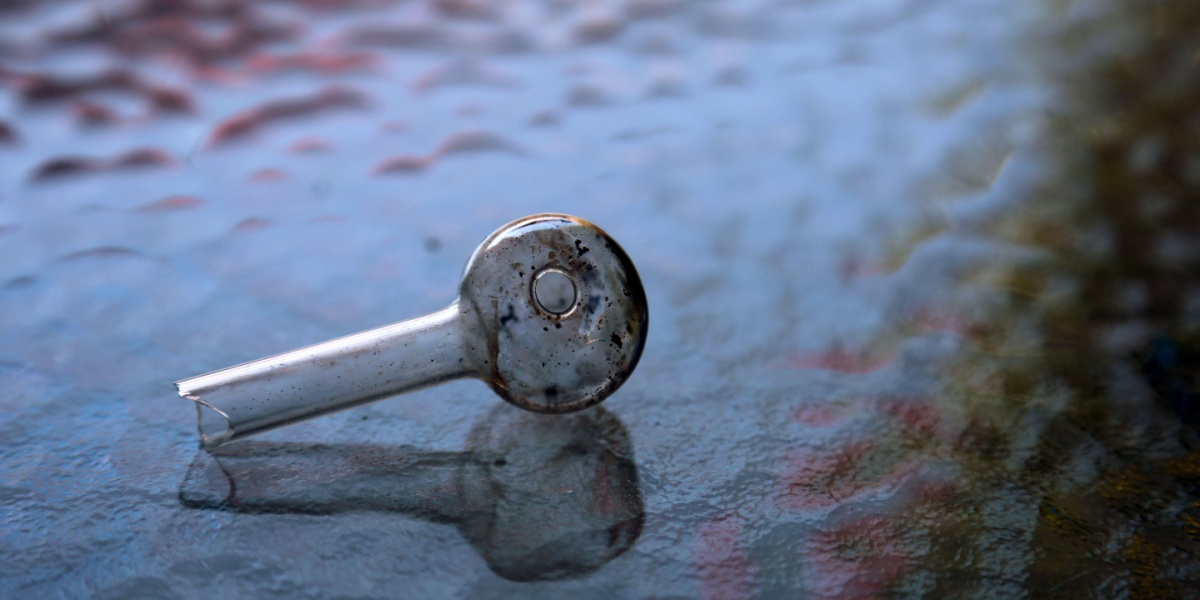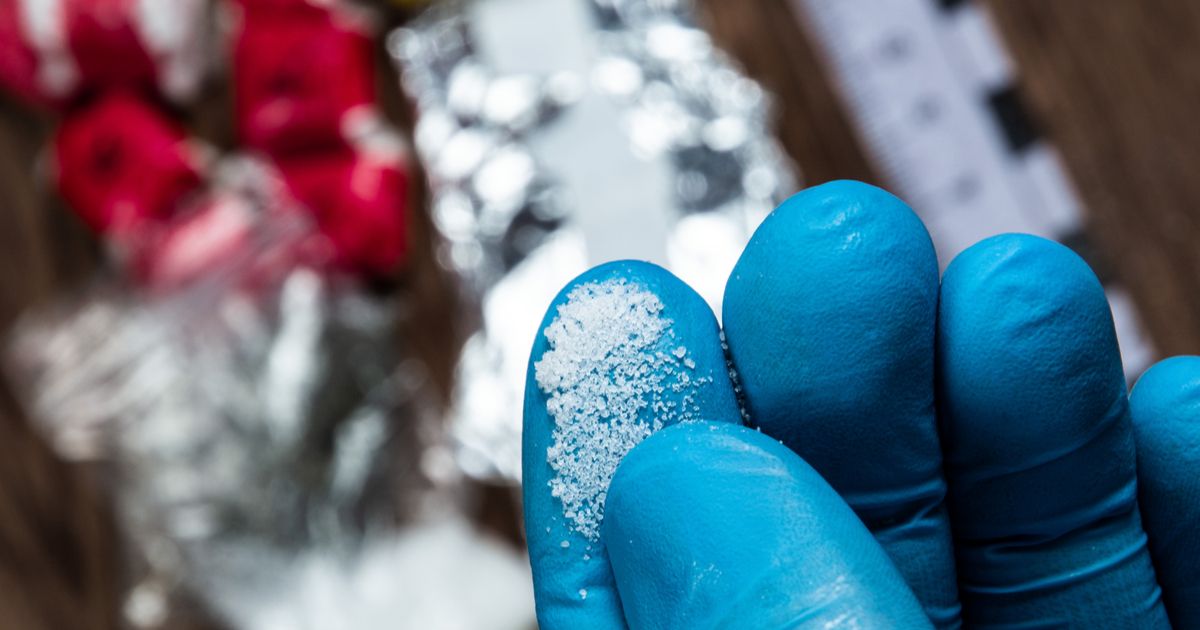Methamphetamine is a powerful illicit stimulant that can be smoked, snorted, or injected. Common street names for methamphetamine include meth, crank, speed, chalk, tina, and, for the crystal form, ice, glass, or crystal. The 2021 National Survey on Drug Use and Health reported that 0.6% of the American population aged 12 or older had a meth use disorder in the past 12 months. The majority of lethal overdoses due to psychostimulants are due to meth.[1] One of the more common methods of taking meth is through smoking the substance, often through a glass bowl pipe, often referred to as a “meth pipe.”
- Methamphetamine and crystal meth are illegal psychostimulants drugs with a high risk for addiction that can be smoked, ingested, injected, or snorted.
- Meth overdose is a significant cause of death in the United States.
- Meth pipes are thin, cylindrical glass tubes with a round, bulbous end similar to crack pipes that allow users to smoke meth.
- Meth pipes increase the risk of lung disease and physical burns to the hands and lips. Homemade pipes increase the risk of combustion, explosion, and poisoning from inhaling unintended substances.

Methamphetamine appearance
Methamphetamine powder is usually white, but impurities can give it an off-white or yellowish tinge, occasionally slightly pink in appearance. The powder can be snorted or dissolved in water or alcohol and injected. Pills can be ingested. Crystal meth is a purer form that resembles glass shards and is often smoked in pipes.
How is meth taken?
The preferred method of meth use varies depending on the type of meth being used, geographical location (e.g. some areas have higher rates of smoking meth than others), and changing patterns and trends of drug use over time.[1] A recent study in rural Illinois reported that all sampled meth users smoked meth and 84% injected it as well.[2]
What does a meth pipe look like?
At very high temperatures, meth crystals vaporize, producing a smoke that can be inhaled. Thus, meth pipes are made of glass or metal that can withstand high temperatures.
Related guide: Hot railing methamphetamines
Similar to crack pipes, meth pipes (also called bubble pipes) are often thin, cylindrical glass tubes with a round, bulbous end. The meth is packed into a hole in the round end, which is heated over a flame until inhalable vapors are created. The process avoids combustion, which preserves the drug’s potency. However, pipes still pose significant health risks, including lung damage, burns, and long-term addiction issues.
A mouthpiece, often made from silicone or rubber, can be attached to the pipe’s stem to reduce the risk of burns to the lips, which can occur when the glass becomes hot during use. Similarly, heat-resistant gloves can protect the hands. Used pipes will often be black at the end with a yellow, waxy residue inside.
Although some businesses may resort to selling meth pipes disguised as oil diffusers or pots for plants, the selling and possession of meth pipes is illegal. For this reason, many meth users, resort to making their own makeshift tools for smoking meth.
Home made meth pipes
Common homemade meth-smoking devices include:
- Tinfoil that has been folded or creased
- Empty pens or glass vials
- Lightbulbs with the inner parts removed
- Tin cans with holes poked in them
- Metal pipes (for example from car antennas)
Like glass meth pipes, these items will often be blackened or have yellow residue covering the inside.
When heated at high temperatures, plastic, aluminum foil, and other household items can release toxic fumes or chemicals that increase the risk of lung damage or poisoning. Some substances, particularly plastic or rubber, may catch fire or even explode.
Snorting meth: Straws, tubes, and pens
Rolled-up dollar bills or paper straws are not as commonly used when snorting meth as the substance can stick to the inside.
Meth does not easily stick to plastic or metal materials making these the preferred items used to snort meth.
Cut plastic straws, empty glow sticks, and hollowed plastic pens are also popular inhalation devices when smoking meth using tin foil. Snorting drugs like meth can lease to nasal perforation.
Injecting meth: Needles and syringes
Finding syringes and hypodermic needles in someone's possession (if they don't have a medical reason to own them) is always a worrying sign of substance abuse.
Related guide: Needle Exchange Programs
Pumping substances into the bloodstream intravenously gets the drug into the system faster and often causes a more intense high. Using meth, heroin, and other substances this way holds a higher possibility of overdosing, especially as drugs are often cut with dangerous ingredients such as fentanyl.
There is also the increased risk of catching blood diseases such as HIV from sharing needles.
If someone you know has needles, tunicates or other tubing, and burnt spoons in their possession, or if they have visible signs such as track marks on the arms or between twos and fingers, then it is likely they are injecting drugs.
Teen meth abuse is a worrying problem in America, especially if they are injecting the drug. Knowing how to approach a teen or young person about drug abuse can ensure they get the help they need.
Additional meth paraphernalia
As well as the above, there are additional pieces of meth paraphernalia. Some common items used when taking meth include:
- Small mirrors and razor blades (used for cutting meth when snorting)
- Burnt spoons, lighters, or tin foil (used for cooking meth)
- Dried up cotton balls (used to strain meth)
- Baggies (usually with traces of crystalline powder or shards inside)
Effects of using meth pipes
When smoked or injected, meth results in a rush or flash of euphoria, energy, talkativeness, and loss of appetite that may last between 5 to 30 minutes. Other effects may include increased body temperature and an irregular heartbeat. Snorting or ingesting meth often results in slower and less intense effects.
Related blog: Can Damaged Skin Heal After Meth Addiction?
The “high” of meth is followed by a “crash” characterized by extreme fatigue, irritability, anxiety, depression, and intense drug craving. For this reason, users often take multiple hits in a session, and meth is considered highly addictive. The “binge and crash” cycle is characteristic of meth abuse and may lead to days of prolonged use without sleep, followed by extensive crash periods.
Long-term abuse of meth results in many side effects, including addiction. Chronic users are less sensitive to meth and need increasing amounts of the drug. While withdrawal results in the negative effects described above, chronic users often lose the ability to feel pleasure outside of meth, which increases the risk of overdose.[3]
Overdose is characterized by agitated or violent behavior, hyperthermia (high body temperature), chest pain or arrhythmia (irregular heartbeats), breathing difficulty or cessation, nausea or vomiting, blurred vision, and hallucinations. In the event of a meth overdose, or an emergency such as seizures, unresponsiveness, or breathing difficulties, call 911 or a medical professional for immediate care.
For information on staying safe while using meth, visit here to help, a mental health and substance use resource dedicated to harm reduction and safety.
Helping someone with a methamphetamine use disorder
Methamphetamine use disorder, or meth addiction, is characterized by a pattern of compulsive use despite harmful consequences, which often leads to physical, psychological, and behavioral issues. Increased tolerance, strong urges to use the drug, using more than planned, or neglecting responsibilities due to meth are early signs of meth addiction.
Paranoia, anxiety, hallucinations, withdrawal from friends and family, inability to quit, hallucinations, and cognitive impairment (such as difficulty focusing or remembering things) are more advanced signs of meth addiction. Physical symptoms include extreme weight loss, skin sores, and teeth loss.
If you suspect meth addiction in yourself or a loved one, help is available. There are a range of treatment options, such as residential care and outpatient programs, as well as support groups and counseling options. Get in touch with an advisor today or visit our rehab directory to see what support is available.



-guide-detail.jpg?v=1722502261)
